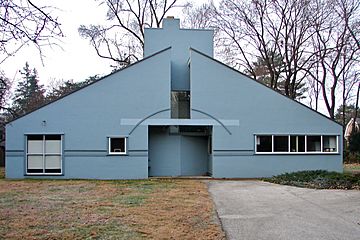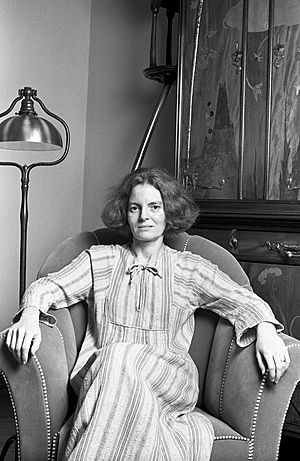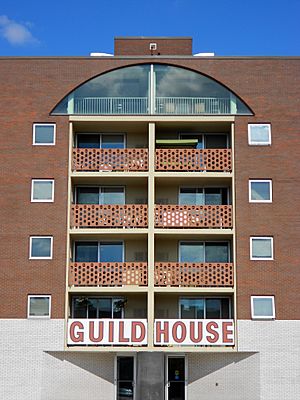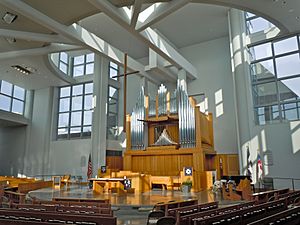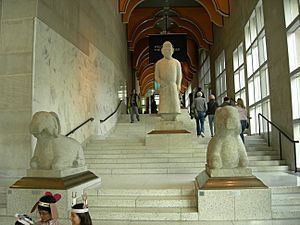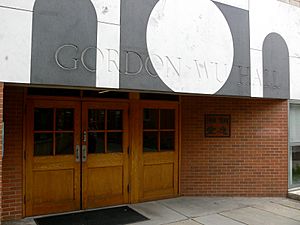Robert Venturi facts for kids
Quick facts for kids
Robert Venturi
|
|
|---|---|
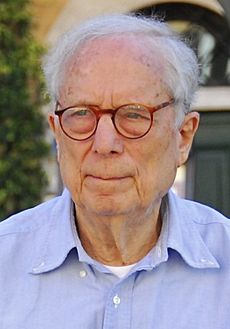
Venturi in Rome, 2008
|
|
| Born |
Robert Charles Venturi Jr.
June 25, 1925 Philadelphia, Pennsylvania, U.S.
|
| Died | September 18, 2018 (aged 93) Philadelphia, Pennsylvania, U.S.
|
| Alma mater | Princeton University |
| Occupation | Architect |
| Spouse(s) | |
| Children | 1 |
| Awards |
|
| Practice |
|
Robert Charles Venturi Jr. (June 25, 1925 – September 18, 2018) was a famous American architect. He started the firm Venturi, Scott Brown and Associates. He was one of the most important architects of the 1900s.
Robert Venturi and his wife, Denise Scott Brown, changed how people thought about buildings. Their designs, writings, and teaching helped many architects and students.
Venturi won the Pritzker Prize in 1991. This is a very important award in architecture. He also famously said, "Less is a bore." This was a playful response to another architect's saying, "Less is more." Venturi lived in Philadelphia with Denise Scott Brown. He had a son named James Venturi.
Contents
Early Life and Education
Venturi was born in Philadelphia, Pennsylvania. He grew up in a Quaker family. He went to school at the Episcopal Academy in Merion, Pennsylvania.
He studied at Princeton University and graduated in 1947. He earned his Master of Fine Arts degree from Princeton in 1950. His teachers helped him learn to think about architecture in new ways. He learned to use ideas from history and everyday buildings.
In 1951, he worked for famous architects like Eero Saarinen and Louis Kahn. He then won a special award, the Rome Prize Fellowship, in 1954. This allowed him to study and travel in Europe for two years.
From 1959 to 1967, Venturi taught at the University of Pennsylvania. There, he met Denise Scott Brown, who was also an architect and teacher. They later taught together at other universities, including Yale School of Architecture and Harvard University.
Venturi's Ideas About Architecture
Venturi was a strong voice against the simple, plain buildings of modern architecture in the 1950s. He felt these buildings often lacked meaning. In 1966, he wrote an important book called Complexity and Contradiction in Architecture.
This book showed how buildings could be rich and interesting. He used examples from old buildings and everyday structures. He argued for "the difficult whole" instead of overly simple designs. This book has been translated into 18 languages.
In 1968, Venturi and Scott Brown led a study of the Las Vegas Strip. This was a very unusual choice for a serious study. They wanted to learn from the bright lights and signs of everyday places. In 1972, they published a book called Learning from Las Vegas.
This book was another challenge to traditional modern architecture. They introduced ideas like "Duck" and "Decorated Shed." A "Duck" is a building shaped like what it sells (like a hot dog stand shaped like a hot dog). A "Decorated Shed" is a simple building with lots of signs and decorations on it. Venturi and his firm often designed "Decorated Sheds."
Venturi's Buildings and Designs
Robert Venturi's buildings helped change American architecture. He moved it away from simple modern styles. He showed how buildings could learn from history and fit into their surroundings.
Venturi's designs often mixed different styles and ideas. This "inclusive" approach was different from modern architects who tried to make everything perfectly simple. His early buildings were surprising. They had unusual shapes, uneven parts, and bold graphics. Examples include the North Penn Visiting Nurses Headquarters and the Vanna Venturi House.
In 1960, Venturi started his first firm. He was inspired by old masters like Michelangelo and Andrea Palladio. He also admired modern architects like Le Corbusier and Louis Kahn.
In 1967, he married Denise Scott Brown. She joined his firm in 1969. The firm's name changed over time to Venturi, Scott Brown, and Associates. Their office was in Philadelphia. In 1985, their firm won the Architecture Firm Award. They designed many buildings for universities and cities around the world.
Venturi's architecture has had a big impact globally. His ideas influenced many other famous architects. He was a member of many important architectural groups.
Death
Robert Venturi passed away on September 18, 2018, in Philadelphia. He was 93 years old. He died from problems related to Alzheimer's disease.
After his death, many people shared how much he inspired them. Michael Kimmelman, an architecture critic, said Venturi "opened millions of eyes and whole new ways of thinking." He praised Venturi's work with Denise Scott Brown for its "wit and humanity."
Selected Works

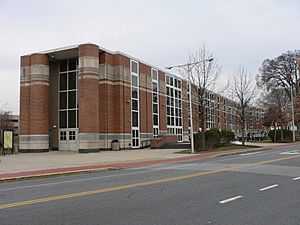
- Vanna Venturi House; Philadelphia (1964). This house won an award and was called a "Masterwork of Modern American Architecture."
- Guild House; Philadelphia (1964).
- The Lieb House; Barnegat Light, New Jersey (1967). This house is famous for a huge number 9 on its front. It was moved to Long Island, New York to save it from being torn down.
- Fire Station #4; Columbus, Indiana (1968).
- Trubek and Wislocki Houses; Nantucket, Massachusetts (1971).
- Allen Memorial Art Museum addition, Oberlin College; Oberlin, Ohio (1976).
- Franklin Court; Philadelphia (1976).
- Western Plaza, now Freedom Plaza; Washington, D.C. (1980).
- Gordon Wu Hall; Princeton University, New Jersey (1983).
- Lewis Thomas Laboratory, Princeton University, New Jersey (1986).
- Sainsbury Wing, National Gallery, London; United Kingdom (1991).
- Seattle Art Museum; Seattle, Washington (1991).
- Restoration of the Fisher Fine Arts Library, University of Pennsylvania; Philadelphia (1991).
- Children's Museum; Houston, Texas (1992).
- University of Delaware, Trabant Student Center (1996).
- Mielparque Nikko Kirifuri Resort; Nikko National Park, Japan (1997).
- Frist Campus Center, Princeton University; New Jersey (2000).
- Episcopal Academy Chapel; Newtown Square, Pennsylvania (2008).
Awards and Honors
- Fellow, American Academy in Rome; 1954-1956
- AIA Medal for Complexity and Contradiction in Architecture; 1978
- Fellow in the American Institute of Architects, 1978
- AIA Architecture Firm Award, to Venturi, Rauch and Scott Brown; 1985
- Twenty-five Year Award for the Vanna Venturi House; 1989
- Elected to the American Academy of Arts and Letters; 1990
- The Pritzker Architecture Prize; 1991
- National Medal of Arts, United States Presidential Award; 1992 (with Denise Scott Brown)
- Vincent Scully Prize, National Building Museum; 2002 (with Denise Scott Brown)
- Design Mind Award, Cooper-Hewitt National Design Awards; 2007 (with Denise Scott Brown)
- AIA Gold Medal (with Denise Scott Brown) 2016
Writings
- Complexity and Contradiction in Architecture (1966)
- Learning from Las Vegas (1972, revised 1977) (with Denise Scott Brown and Steven Izenour)
- Iconography and Electronics upon a Generic Architecture: A View from the Drafting Room (1998)
- Architecture as Signs and Systems: for a Mannerist Time (2004) (with Denise Scott Brown)
See also
 In Spanish: Robert Venturi para niños
In Spanish: Robert Venturi para niños


